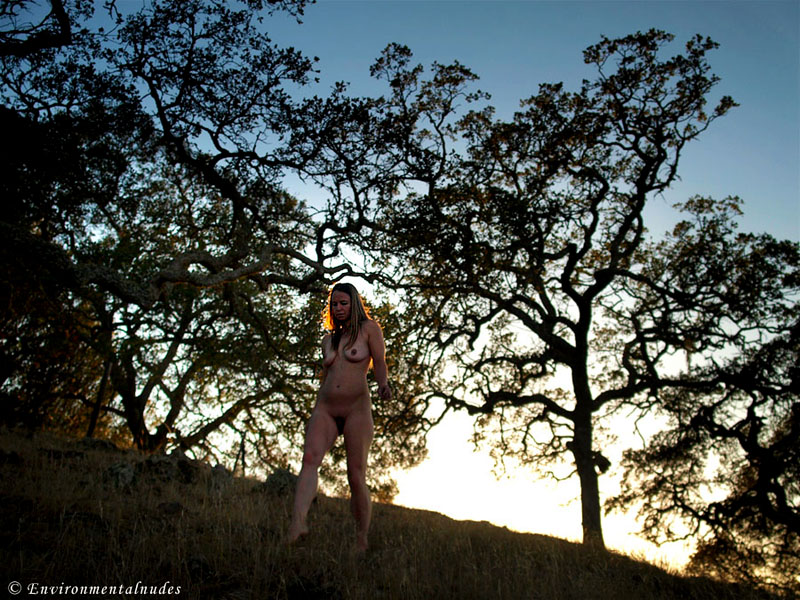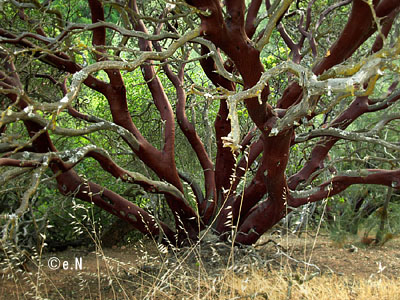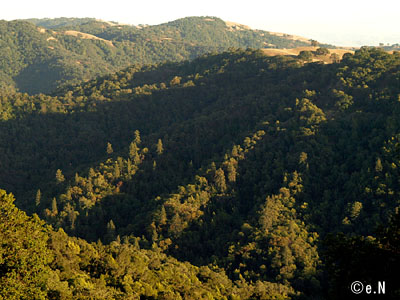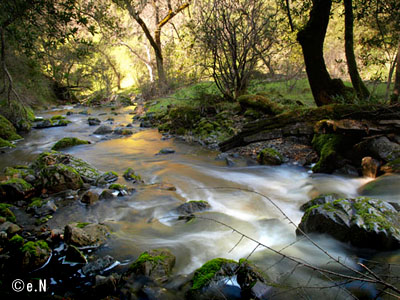|
Wow!
A momentous $10 sale took
place November 1958 as
Coe
Park
transferred from
Santa Clara
County
to the State of
California
. Henry W. Coe State Park now reigns as
Northern California
’s biggest state park. It
further ranks second largest in the entire state, where Southern
California’s
Anza-Borrego
Desert
takes lead with the most sizable land mass.
A portion of Coe park keeps devoted to the Orestimba Wilderness
Area preservation project.
Now comprised of close
to 88,000 acres of wild space, the park features varied terrain
appealing to hikers, equestrians, bikers, backpackers and other leisure
travelers. Here rolling hills mix with high ridges, grasslands with
steep canyons, small lakes and ponds with seasonal streams. Former
cattle ranching reservoirs also dot rugged landscape.
Initially
a county park, generous land donation by Sada Coe Robinson the
granddaughter of Henry W. Coe Jr. enabled inception.
Native Americans, the Ohlone tribe first called these lands home;
where they partook and lived harmoniously upon nature’s abundant
offerings. Later settlers arrived and in 1905 the Coe Family established
13,000 acre Pine Ridge Ranch for raising cattle.

Following Sada’s gift, sizable expansion occurred with additional
tracts of land acquired, most notably in the 1980s and 1990s. Although
closure has been threatened at times based on state budget constraints,
the park is reportedly still growing. Part of the
Diablo
Range
of the
California
Coastal
Ranges
, it now lies within both
Santa Clara
and
Stanislaus
Counties
. Volunteer activism plays a vital role.
Little time travel to fuel the imagination - rifts and tectonics.
A beautiful name Pangea graces
the supercontinent from which the North American continent broke away
from some 200 million years ago for westward movement. In the push west,
other oceanic plates were encountered, mostly submerged to disappear
below the sea. While our prior continental edge was being obliterated,
scrap material extruded as the plates jammed together. The
California
Coastal
Range
appeared.
Earthquake
country,
Coe
Park
contains two faults curved in an egg shape: the Madrone Springs and the
Tesla-Ortigalita. Sediment which rose to help form the coastal range is
made up of majority share sandstone in a jumbled mass. Serpentine and
Bluechist add splashes of blue/green colors to rock formations.
Scattered, less common garnet may be found upon closer examination.

Bell Station, technically the lowest elevation the Park around 300 feet
above sea level serves solely as an access way. Days gone-by it was used
by gold miner Lafayette Bell who in 1863 purchased then operated a small
tavern and telegraph station on the old Pacheco Pass Turnpike toll road.
His restaurant site proved a rest stop for travelers on the
transcontinental
St Louis
to San Francisco Stage Coach Line. The
historic Bell Station entrance allows access from east direction.
Highest
elevation reaches around 3,500 feet at the park’s northern boundary on
the slopes of outlying Mt Stakes. Mountains covered on the map - Mustang,
Walsh, and
Burra
Burra
Peaks
among others. Roughly 300 miles of outstanding hiking trails and more than
10 miles of dated ranch roads wait for the visitor to explore. Fishing is
allowed in remote places and camping available on drive, hike or bike-in
basis. Coyote, Pacheco, and Orestimba Creeks flow make up prominent
watersheds.
Surrounding wildlife include deer, elk, rabbit, coyote, raccoon, squirrel
and the elusive not-often-seen badger among other mammals. Watch out for
the wild pigs! Bird friends such as eagles, hawks, owls, quail and blue
birds come seen. Reptiles, known in existence from the time of Pangea,
consist of lizards and snakes that may dart under foot. Listen for the
wonder of frogs and toads. Marvel at the dance of butterflies and
dragonflies as they skip across paths and skim the water’s surface when
the season is ripe.

Shelter from the rain, a canopy, an interface between earth and sky
– trees provide an eternal life force. Storied, if their limbs could
talk from all embraced on planet earth many tomes would spell forth. Protected
from intrusion, the park is known for intact native plant life kept tucked
away from large stands of non-native trees or shrubs. Various species of
oak predominate. Manzanita, blue elderberry,
California
buckeye, alder, pacific madrone, laurel, juniper, gooseberry, mountain
mahogany and pine also impart beauty and wisdom through the ages.
For ten bucks – another wow! Well worth the price of admission.
Good to remember the best things in life often come free. Fall leaves
turning color, perfect for fabulous head turning, pleasurable visit to
Henry
W.
Coe
State Park
. Our well-accomplished
photographer Steve brings it all vividly to life > in more ways than
one!
-
Palmyra
June-July
Feature of the Month Click Here
|



